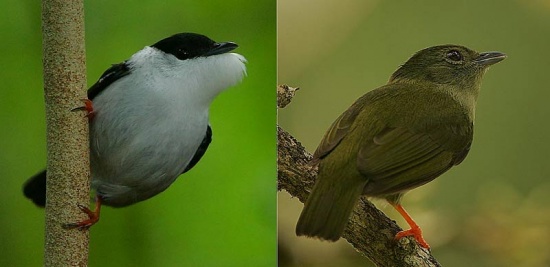- Manacus manacus
Identification
10–11 cm (4-4¼ in).
- Black crown, upper back, wings and tail
- White underparts
- Greyish flanks and rump
Female and young males are olive-green.
Legs are bright orange to red in both males and females.
Similar species
Females are very difficult to separate from females of other Manacus Manakins.
Distribution
South America: found from Colombia, Venezuela and Trinidad east through the Guianas and south to Bolivia and northern Argentina.
Taxonomy
Subspecies
15 subspecies are recognized[1]:
- M.m. abditivus: Santa Marta, lower Cauca and middle Magdalena valleys
- M.m. flaveolus: North Colombia (tropical upper Magdalena Valley)
- M.m. bangsi: Tropical south-western Colombia and extreme north-western Ecuador
- M.m. interior: Colombia (east of the Andes) to eastern Ecuador, northern Peru and north-western Brazil
- M.m. trinitatis: Trinidad
- M.m. umbrosus: Tropical southern Venezuela (Amazonas)
- M.m. manacus: South Venezuela to the Guianas and northern Brazil
- M.m. leucochlamys: Tropical north-western Ecuador (Esmeraldas, Manabí and Guayas)
- M.m. maximus: Tropical south-western Ecuador (El Oro and western Loja)
- M.m. expectatus: Tropical north-eastern Peru (Loreto) and adjacent western Brazil
- M.m. longibarbatus: Lower Amazonian Brazil (River Xingú to River Tocantins)
- M.m. purissimus: East Brazil (River Tocantins to south-eastern Pará and northern Maranhão)
- M.m. gutturosus: South East Brazil (Alagoas) to eastern Paraguay and north-eastern Argentina
- M.m. purus: North Brazil (River Madeira to River Tapajós and south-western Pará)
- M.m. subpurus: South-central Brazil (south-eastern Amazona, eastern Rondônia and north-western Mato Grosso)
Habitat
Lowland forests and especially second growth, often at borders to roads and other human influenced areas.
Behaviour
Breeding
Males display in leks low over the rainforest floor. The bird jumps from ground onto a vertical branch and down again, at the same time making explosive snapping sounds.
Diet
The diet consists mostly of small fruit and insects.
References
- Clements, J. F., T. S. Schulenberg, M. J. Iliff, D. Roberson, T. A. Fredericks, B. L. Sullivan, and C. L. Wood. 2017. The eBird/Clements checklist of birds of the world: v2017, with updates to August 2017. Downloaded from http://www.birds.cornell.edu/clementschecklist/download/
- Handbook of the Birds of the World Alive (retrieved May 2018)
Recommended Citation
- BirdForum Opus contributors. (2024) White-bearded Manakin. In: BirdForum, the forum for wild birds and birding. Retrieved 8 November 2024 from https://www.birdforum.net/opus/White-bearded_Manakin




